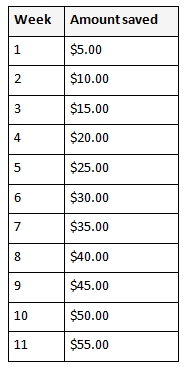Personal Finance Big Ideas taught in this task:
TASK
Louis wants to give $15 to help kids who need school supplies. He also wants to buy a pair of shoes for $39.
- How much money will he have to save for both?
- Louis gets $5 a week for his allowance. He will save his allowance every week. How many weeks will it take him to reach this goal?
- Louis remembers his sister’s birthday is next month. He sets a goal of saving $16 for her gift. How many weeks will he have to save his allowance to reach this goal? How many weeks will he have to save his allowance for all three?
COMMENTARY
The purpose of this task is for students to relate addition and subtraction problems to money and to situations and goals related to saving money. This problem shows the difference between first and second grade students’ strategies for adding 2-digit numbers. In first grade, students are just beginning this work; see Saving Money 1 for an example of a solution approach that is appropriate for first grade. In second grade students should add two-digit numbers fluently (see 2.NBT.B.5); the solution below is written much more abstractly in this version of the task to reflect that transition.
Second graders learn to skip-count by 5′s, 10′s, and 100′s (see 2.NBT.2) and work with equal groups of 2′s and 5′s (see 2.OA.C) both to support their understanding of place-value and in preparation for formal work with multiplication in third grade. This task is an instructional task that brings many aspects of the mathematical work that second graders will be doing together with an opportunity to learn about financial literacy concepts.
Teachers can make the problem more personal by letting the student choose a toy he/she wants and the toy their sibling or friend may want and researching the costs. If students do this type of research, they will be engaging in MP 4, Model with mathematics. Students can also choose how much money they want to donate and for what cause. If the students in the class don’t receive allowance, the child in the task can make money by helping a neighbor (perhaps walking a dog or bringing in the mail).
This task is part of a set collaboratively developed by Money as You Learn, an initiative inspired by recommendations of the President’s Advisory Council on Financial Capability, and Illustrative Mathematics. Integrating essential financial literacy concepts into the teaching of the Common Core State Standards can strengthen teaching of the Common Core and expose students to knowledge and skills they need to become financially capable young adults. A mapping of essential personal finance concepts and skills against the Common Core State Standards as well as additional tasks and texts will be available at www.moneyasyoulearn.org. This task and additional personal finance-related mathematics tasks are available at www.illustrativemathematics.org and are tagged “financial literacy.”
SOLUTION: USING AN EMPTY NUMBER LINE
- Louis needs to save 15+39 dollars:
15 + 39 =
10 + 5 + 30 + 9 =
10 + 30 + 5 + 9 =
40 + 10 + 4 =
54So Louis needs to save $54.
- If we count up by fives, we can see how long it will take:

So it will take Louis 11 weeks to save enough money for both.
- If we look at the number line above, we can see it will take Louis 4 weeks to save enough for his sister’s birthday present.
To save enough for all three, Louis needs to save 54+16 dollars:
54 + 16 =
50 + 4 + 10 + 6 =
60 + 10 =
70So Louis needs to save $70 for all three things. If we continue to count by fives:

we can see that it will take him 14 weeks altogether. The reason it took one less week than if we had added up the number of weeks we found above is that the extra money earned in the 4th week above and beyond what he needed for his sister’s present combined with the extra money saved in the 11th week equals one week’s allowance.
SOLUTION: RECORDING THE SAVINGS IN A TABLE
- Louis needs to save 15+39 dollars:
15 + 39 =
10 + 5 + 30 + 9 =
10 + 30 + 5 + 9 =
40 + 10 + 4 =
54So Louis needs to save $54.
- If we count up by fives, we can see how long it will take:

So it will take Louis 11 weeks to save enough money for both.
- If we look in the table above, we can see it will take Louis 4 weeks to save enough for his sister’s birthday present.
Louis needs to save 54+16 dollars:
54 + 16 =
50 + 4 + 10 + 6 =
60 + 10 =
70
So Louis needs to save $70 for all three things. If we extend the table above, we can see how long it will take:

The reason it took one less week than if we had added up the number of weeks is that the extra money earned in the 4th week above and beyond what he needed for his sister’s present combined with the extra money saved in the 11th week equals one week’s allowance.

